“When a boat stacked with gravel moors at a jetty in Yangon, 14-year-old Aung Htet Myat fills a basket he then carries on his back to trucks that whisk the load to construction sites springing up across Myanmar's booming biggest city. For each basket a labor broker rewards the boy with a stick he puts in a plastic bottle tied to his belt. At the end of the shift, which at the busiest times can last up to 24 hours, he exchanges the sticks for cash – 100 baskets earns him about $2.50. “I carry baskets with stones the whole day”, said Aung Htet Myat, who has worked at the jetty for the last two years. “If there is no gravel boat to unload, I help bus drivers as an assistant”. One-in-five children in Myanmar aged 10-17 go to work instead of school, according to figures from a census report on employment published last month, and the opening up of the economy since 2011 has triggered a spike on demand for labor.
Than Than Win and her two teenage sons began working at the same jetty as Aung Htet Myat after her husband died. The family now rely on a labor broker who lends her money in return for on-demand, non-stop work when a boat arrives. “He gives us a place to stay and we can also take money from him when we have no job”, said Than Than Win, as nearby her sons carried another load of gravel on their backs. “We have no way to pay it back, so whenever he asks us to work we can't refuse”. Her story is common in Yangon's slums, filled with people who have flocked from the countryside as the economy has boomed, says Michael Slingsby, an urban poverty expert based in the city. “People borrow money from lenders and in order to repay their debts children are being sent out to work”, he said.
Myanmar law bars children under 13 from working in shops or factories, and says teenagers aged 13-15 should not work more than four hours a day, or at night. Outside of construction, child labor is most visible in hospitality, with even small children serving food in Myanmar's ubiquitous tea shops. Many children also work in fish farming and processing. At Yangon's San Pya fish market, the country's largest, over two days in February Reuters found girls and boys as young as nine cleaning and processing fish and unloading boats and trucks during 12-hour overnight shifts. “I don't want my son to do this kind of hard labor”, said Hla Myint, 56, whose 15-year-old son works in San Pya. Speaking from their home in a dilapidated bamboo hut close to the river bank, Hla Myint did not share many of his fellow citizens' high hopes for Suu Kyi's government. “Whatever they say they would do, or give us, it will never reach here," he said. "I don't believe in any change”. – Antoni Slodkowski, Timothy McLaughlin, Aung Hla Tun, Simon Webb and Swan Pyae Win Aung via Reuters
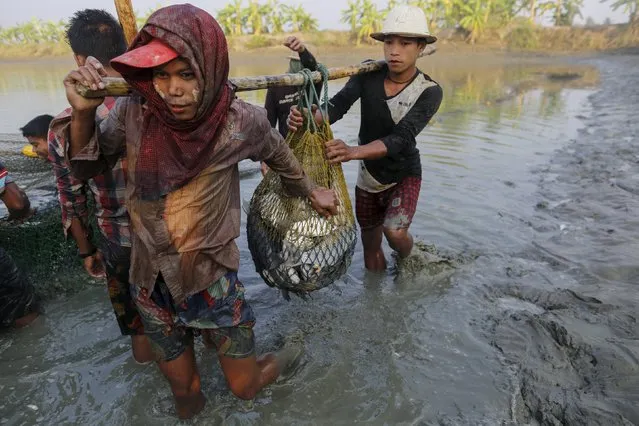
Workers carry a net full of fish as they carry out harvesting at a fish farm in Htantapin township, outside Yangon, Myanmar February 18, 2016. One in five children in Myanmar aged 10-17 go to work instead of school, according to figures from a census report on employment published last month, and the opening up of the economy since 2011 has triggered a spike in demand for labour. Many children work in fish farming and processing. At Yangon's San Pya fish market, the country's largest, girls and boys as young as nine clean and process fish and unload boats and trucks during 12-hour overnight shifts. (Photo by Soe Zeya Tun/Reuters)
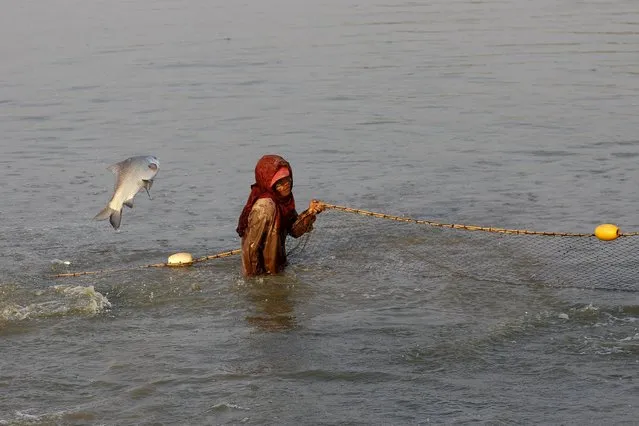
A fish jumps over a net as a boy works in a fish farm at Htantapin township, outside Yangon, Myanmar February 18, 2016. (Photo by Soe Zeya Tun/Reuters)
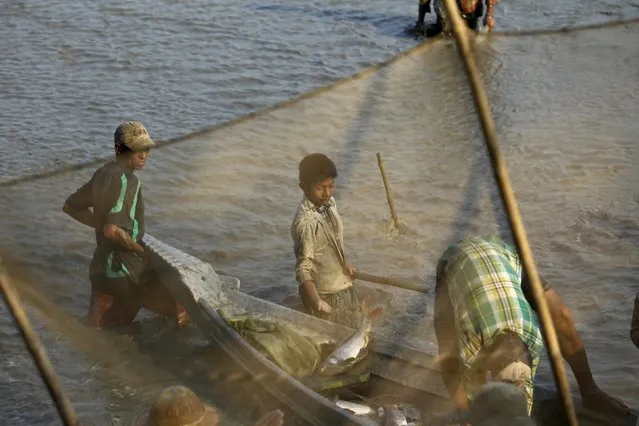
A child uses a fishing net as he and others work at a fish farm in Htantapin township, outside Yangon, Myanmar February 18, 2016. (Photo by Soe Zeya Tun/Reuters)
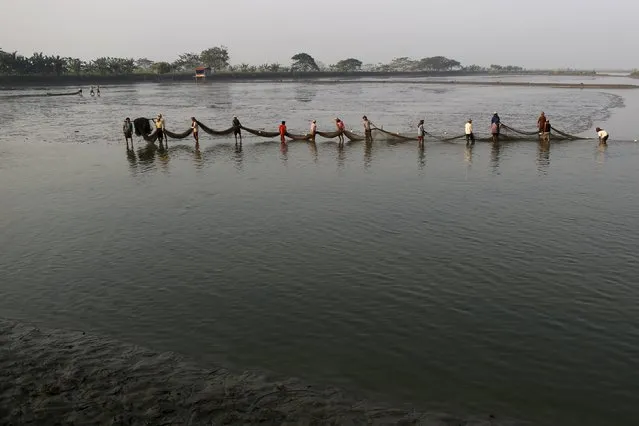
Workers use a fishing net during harvesting at a fish farm in Htantapin township, outside Yangon, Myanmar February 18, 2016. (Photo by Soe Zeya Tun/Reuters)
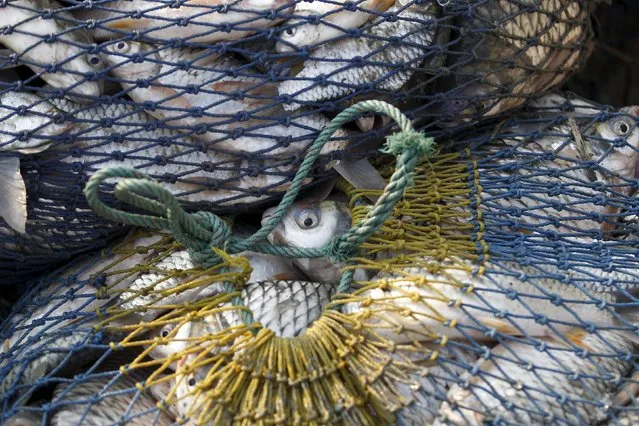
Fish are seen in a net at a fish farm in Htantapin township, outside Yangon, Myanmar February 18, 2016. (Photo by Soe Zeya Tun/Reuters)
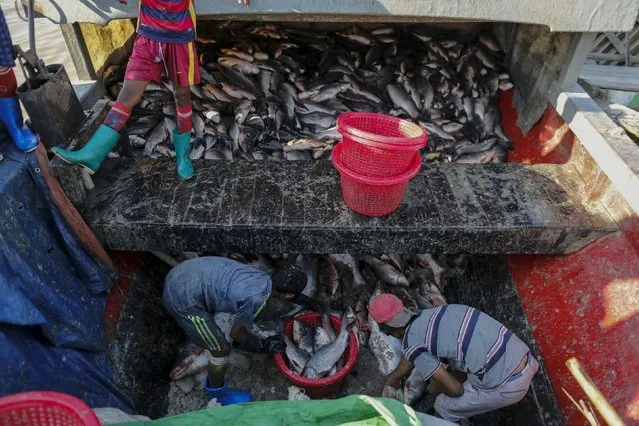
Children unload fish from a boat at San Pya fish market in Yangon, Myanmar February 16, 2016. (Photo by Soe Zeya Tun/Reuters)
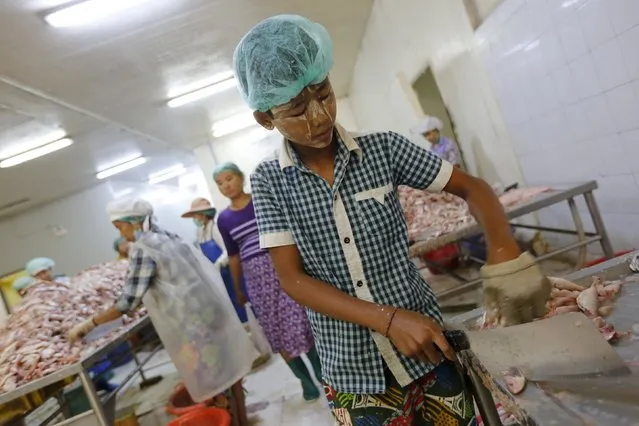
A boy chops fish at a seafood export factory in Hlaingthaya Industrial Zone, outside Yangon, Myanmar February 19, 2016. (Photo by Soe Zeya Tun/Reuters)
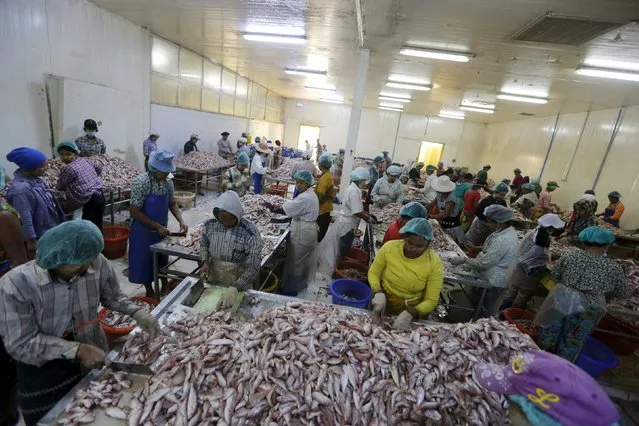
Workers process fish at a seafood export factory in Hlaingthaya Industrial Zone, outside Yangon, Myanmar February 19, 2016. (Photo by Soe Zeya Tun/Reuters)
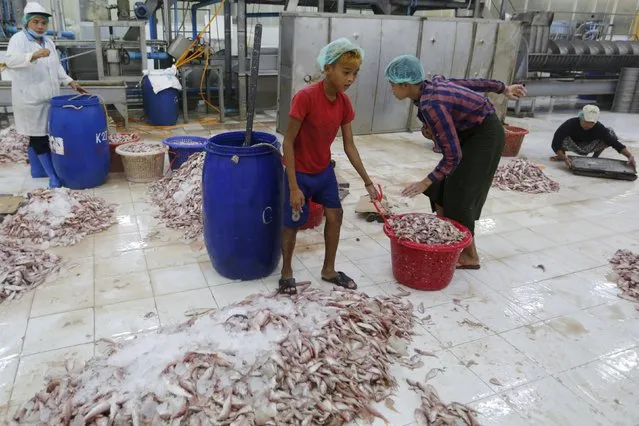
A boy works at a seafood export factory in Hlaingthaya Industrial Zone, outside Yangon, Myanmar February 19, 2016. (Photo by Soe Zeya Tun/Reuters)
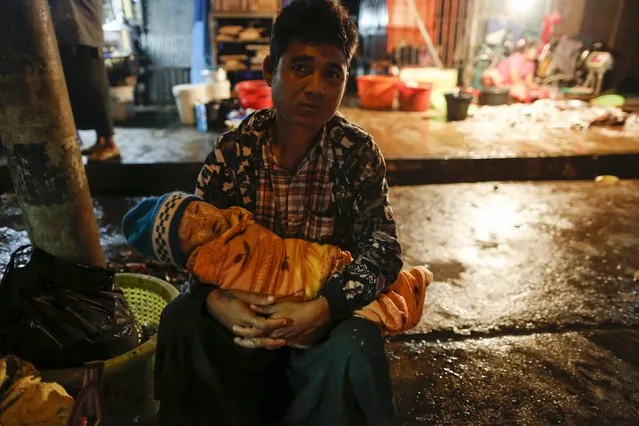
A vendor holds his baby as he waits for a bus after bringing fish to sell at San Pya fish market, in Yangon, Myanmar February 15, 2016. (Photo by Soe Zeya Tun/Reuters)
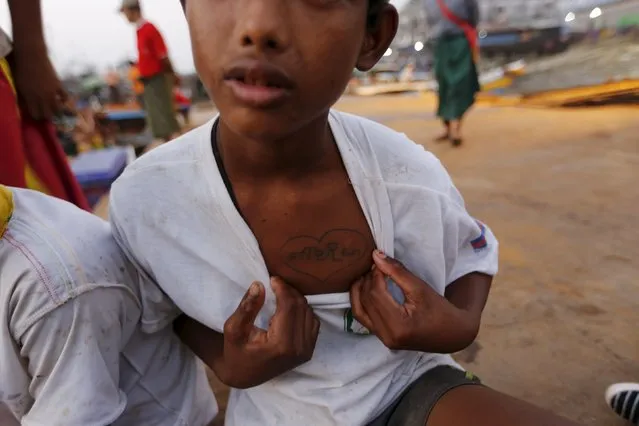
Nay Htet Lin, a 15-year-old worker, shows a heart-shaped tattoo on his chest of his mother's name at San Pya fish market in Yangon, Myanmar February 19, 2016. (Photo by Soe Zeya Tun/Reuters)
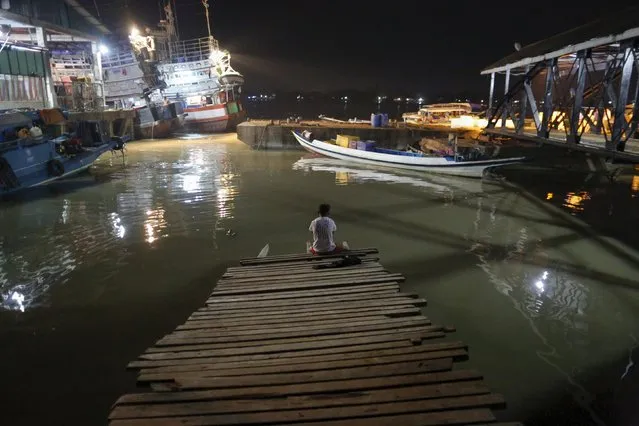
Kyaw Khine Soe, 16, rests on a dock after finishing his shift at San Pya fish market, in Yangon, Myanmar February 16, 2016. (Photo by Soe Zeya Tun/Reuters)
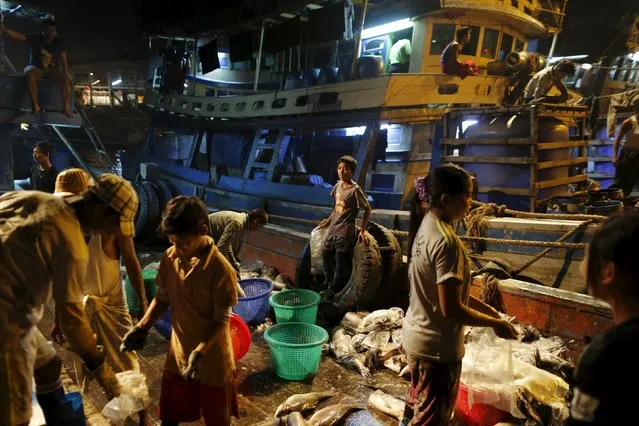
Workers pack fresh fish for export on a ship at San Pya fish market in Yangon, Myanmar February 15, 2016. (Photo by Soe Zeya Tun/Reuters)

Kyaw Khine Soe (R), 16, sits inside his home with his family outside Yangon, Myanmar February 17, 2016. (Photo by Soe Zeya Tun/Reuters)
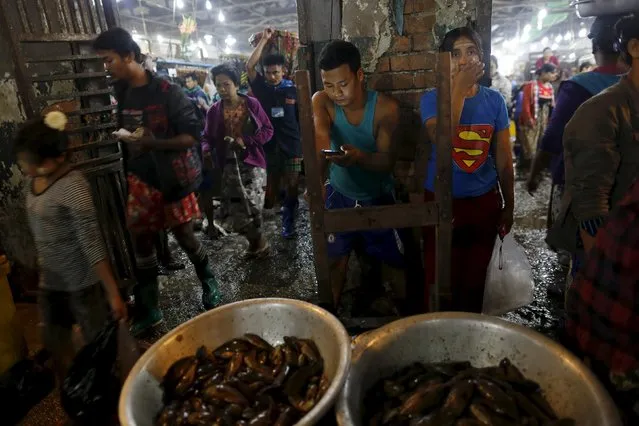
A worker uses his phone at San Pya fish market in Yangon, Myanmar February 15, 2016. (Photo by Soe Zeya Tun/Reuters)
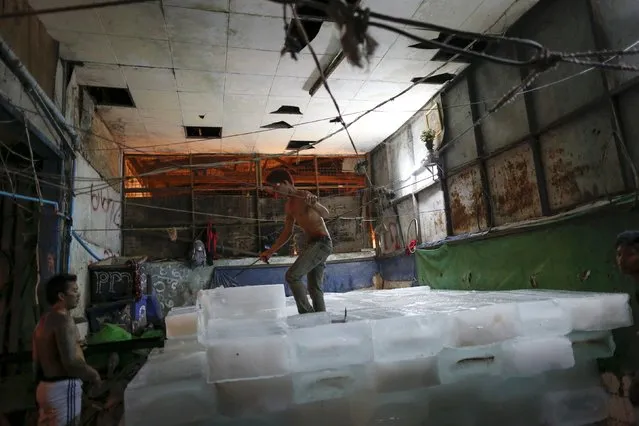
A man arranges blocks of ice at San Pya fish market in Yangon, Myanmar February 16, 2016. (Photo by Soe Zeya Tun/Reuters)
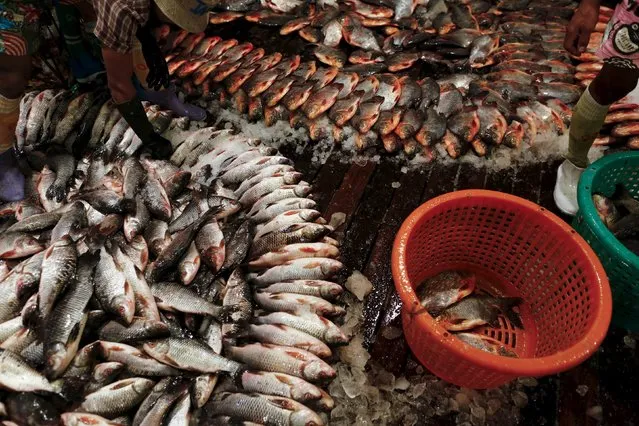
Fish are seen at San Pya fish market in Yangon, Myanmar February 15, 2016. (Photo by Soe Zeya Tun/Reuters)
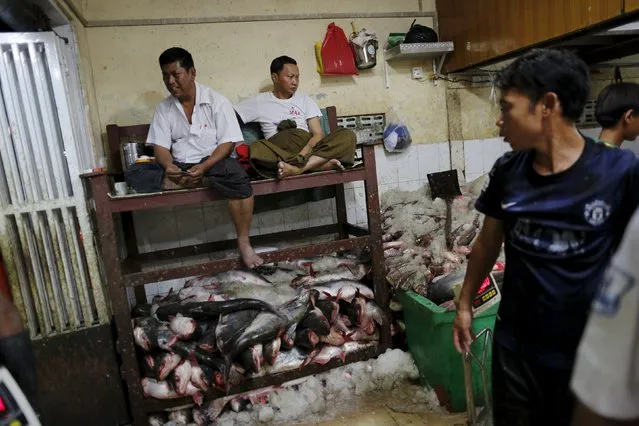
Fish shop owners sit on a bench as they sell their fish at San Pya fish market in Yangon, Myanmar February 16, 2016. (Photo by Soe Zeya Tun/Reuters)
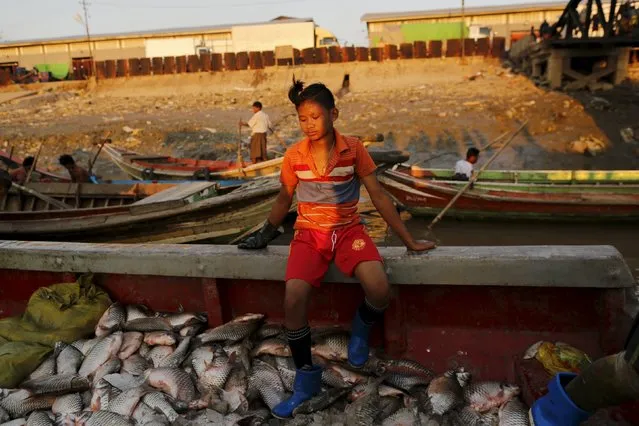
Kyaw Khine Soe, a 16-year-old worker, sits on a boat at San Pya fish market in Yangon, Myanmar February 16, 2016. (Photo by Soe Zeya Tun/Reuters)
Than Than Win and her two teenage sons began working at the same jetty as Aung Htet Myat after her husband died. The family now rely on a labor broker who lends her money in return for on-demand, non-stop work when a boat arrives. “He gives us a place to stay and we can also take money from him when we have no job”, said Than Than Win, as nearby her sons carried another load of gravel on their backs. “We have no way to pay it back, so whenever he asks us to work we can't refuse”. Her story is common in Yangon's slums, filled with people who have flocked from the countryside as the economy has boomed, says Michael Slingsby, an urban poverty expert based in the city. “People borrow money from lenders and in order to repay their debts children are being sent out to work”, he said.
Myanmar law bars children under 13 from working in shops or factories, and says teenagers aged 13-15 should not work more than four hours a day, or at night. Outside of construction, child labor is most visible in hospitality, with even small children serving food in Myanmar's ubiquitous tea shops. Many children also work in fish farming and processing. At Yangon's San Pya fish market, the country's largest, over two days in February Reuters found girls and boys as young as nine cleaning and processing fish and unloading boats and trucks during 12-hour overnight shifts. “I don't want my son to do this kind of hard labor”, said Hla Myint, 56, whose 15-year-old son works in San Pya. Speaking from their home in a dilapidated bamboo hut close to the river bank, Hla Myint did not share many of his fellow citizens' high hopes for Suu Kyi's government. “Whatever they say they would do, or give us, it will never reach here," he said. "I don't believe in any change”. – Antoni Slodkowski, Timothy McLaughlin, Aung Hla Tun, Simon Webb and Swan Pyae Win Aung via Reuters

Workers carry a net full of fish as they carry out harvesting at a fish farm in Htantapin township, outside Yangon, Myanmar February 18, 2016. One in five children in Myanmar aged 10-17 go to work instead of school, according to figures from a census report on employment published last month, and the opening up of the economy since 2011 has triggered a spike in demand for labour. Many children work in fish farming and processing. At Yangon's San Pya fish market, the country's largest, girls and boys as young as nine clean and process fish and unload boats and trucks during 12-hour overnight shifts. (Photo by Soe Zeya Tun/Reuters)

A fish jumps over a net as a boy works in a fish farm at Htantapin township, outside Yangon, Myanmar February 18, 2016. (Photo by Soe Zeya Tun/Reuters)

A child uses a fishing net as he and others work at a fish farm in Htantapin township, outside Yangon, Myanmar February 18, 2016. (Photo by Soe Zeya Tun/Reuters)

Workers use a fishing net during harvesting at a fish farm in Htantapin township, outside Yangon, Myanmar February 18, 2016. (Photo by Soe Zeya Tun/Reuters)

Fish are seen in a net at a fish farm in Htantapin township, outside Yangon, Myanmar February 18, 2016. (Photo by Soe Zeya Tun/Reuters)

Children unload fish from a boat at San Pya fish market in Yangon, Myanmar February 16, 2016. (Photo by Soe Zeya Tun/Reuters)

A boy chops fish at a seafood export factory in Hlaingthaya Industrial Zone, outside Yangon, Myanmar February 19, 2016. (Photo by Soe Zeya Tun/Reuters)

Workers process fish at a seafood export factory in Hlaingthaya Industrial Zone, outside Yangon, Myanmar February 19, 2016. (Photo by Soe Zeya Tun/Reuters)

A boy works at a seafood export factory in Hlaingthaya Industrial Zone, outside Yangon, Myanmar February 19, 2016. (Photo by Soe Zeya Tun/Reuters)

A vendor holds his baby as he waits for a bus after bringing fish to sell at San Pya fish market, in Yangon, Myanmar February 15, 2016. (Photo by Soe Zeya Tun/Reuters)

Nay Htet Lin, a 15-year-old worker, shows a heart-shaped tattoo on his chest of his mother's name at San Pya fish market in Yangon, Myanmar February 19, 2016. (Photo by Soe Zeya Tun/Reuters)

Kyaw Khine Soe, 16, rests on a dock after finishing his shift at San Pya fish market, in Yangon, Myanmar February 16, 2016. (Photo by Soe Zeya Tun/Reuters)

Workers pack fresh fish for export on a ship at San Pya fish market in Yangon, Myanmar February 15, 2016. (Photo by Soe Zeya Tun/Reuters)

Kyaw Khine Soe (R), 16, sits inside his home with his family outside Yangon, Myanmar February 17, 2016. (Photo by Soe Zeya Tun/Reuters)

A worker uses his phone at San Pya fish market in Yangon, Myanmar February 15, 2016. (Photo by Soe Zeya Tun/Reuters)

A man arranges blocks of ice at San Pya fish market in Yangon, Myanmar February 16, 2016. (Photo by Soe Zeya Tun/Reuters)

Fish are seen at San Pya fish market in Yangon, Myanmar February 15, 2016. (Photo by Soe Zeya Tun/Reuters)

Fish shop owners sit on a bench as they sell their fish at San Pya fish market in Yangon, Myanmar February 16, 2016. (Photo by Soe Zeya Tun/Reuters)

Kyaw Khine Soe, a 16-year-old worker, sits on a boat at San Pya fish market in Yangon, Myanmar February 16, 2016. (Photo by Soe Zeya Tun/Reuters)
20 Apr 2016 12:18:00,
post received
0 comments
